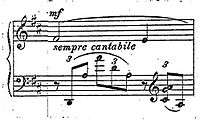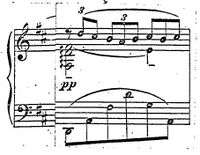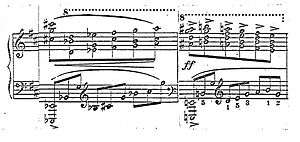Prelude in D major (Rachmaninoff)
The Prelude in D major, Op. 23 No. 4 is a 1903 composition by Sergei Rachmaninoff.[1][2] It is part of Rachmaninoff's Ten Preludes, Op. 23.

Structure
The prelude is in ternary form. The theme of the main section is introduced in measure 3:

Measure 3
The theme is in the form of a period, composed of two symmetrical phrases, the consequent being a more embellished version of the antecedent, presenting a triplet descant in the treble voice above the main theme in the right-hand alto voice. The right-hand voices are offset against an eighth-note figure in the left-hand:

Measure 19
The middle section presents rhythmic changes and several modulations. Triplets appear in the accompaniment, and shorter phrasing is utilized:

Measures 35 and 36
The piece reaches its climax at measures 50–51, and immediately resolves back into the main section:

Measures 50 and 51
Here, the triplet flow returns to the left-hand bass line, while a high counterpoint is introduced in the main melody. Only the antecedent of the original phrase is recapitulated, lengthened by eight additional measures that provide closure.

Measures 53 and 54
Recordings
- YouTube Live Recording Live by Willis Miller (2012).
References
- Norris, Geoffrey, Rachmaninoff, Schirmer Books, 1993 (pg. 170).
- Id.